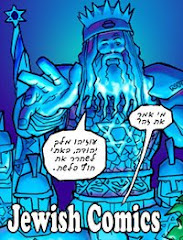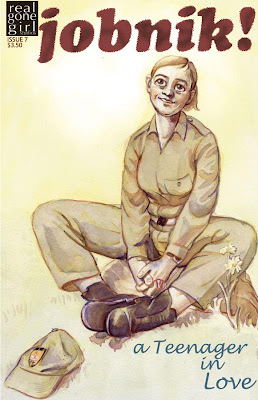Although I try to post time-sensitive information while it's still timely, I often find that my terrible tendency to procrastinate sometimes gets the better of me.
One example of such procrastination is with regards to infomation on courses about Jewish comix. Although most of these (perhaps all) seem to have concluded, I am posting about them for posterity and will try to publicize future ones before they start (assuming I learn about them early enough),
"Zap! Pow! Bam! Oy! Jews, Comic Books & Graphic Novels" was offered at the Anshe Chesed Fairmount Temple High School in Beachwood, Ohio and was taught by Wendy Wasman from Jan. 5th, 2009 to April 27, 2009.
*****
"Jews Superheroes & the World of Comics" was taught by Rabbi Elie Estrin and completed in December 2008. Rabbi Estrin was kind enough to provide the Jewish Comics Blog with his detailed syllabus, reproduced below.
Class One:
Capsule: Early years, Jewish firsts, inner city struggles, angst
Intro: “Everything a Jew sees or hears serves as a lesson to serve G-d.”
Editorial Cartoons to Cartoon Characters to Comic Books
First important Jewish cartoonist – Samuel Zagat, with his characters, most importantly, Gimpl Beinish the Matchmaker, in the paper the Daily Forward, 1910’s
The first comic book – Max Gaines (Ginsburg) “Famous Funnies” to be given away as promotions – 1934
Until that time, there was no protagonist – until Jerry Siegel (an artist) and Joe Shuster (a quiet bodybuilder), who created Superman by give and take (Gaines never did anything with it, but Sheldon Mayer from McClue Syndicate did, creating Action Comics.)
Will Eisner – creator of “The Spirit”, is considered to be the godfather of comics. The Eisner Award – the Oscar of comics. Eisner learned from being an advertising illustrator doing the graveyard shift – seeing shadows, lighting and strange characters.
Eisner and Iger hired former classmate Bob Kane, creator of Batman, as well as fellow Jew and creator of Spiderman and the Fantastic Four, Jack (Kurtzberg) Kirby. He also turned down Superman.
The first package Eisner and Iger's shop created for Fox had specific stipulations: The lead character had to possess super powers, wear a red costume, have a chest insignia, etc. It was obvious that Fox was requesting a knock-off of Superman, which had appeared in mid-1938 and was fueling the comic book boom. Eisner, who had little training in copyright law but plenty of common sense, balked at infringing so blatantly on National's property. Iger tried to assuage Eisner's misgivings by arguing that the two men had little desire to go hungry. Fox himself dubbed the character Wonder Man.
It took National's legal department no time at all to pull the plug on Wonder Man. One night, Fox called Eisner to his office and told him that when the time came for Eisner to take the witness stand in National's instant law suit, Eisner was to swear that there was no intent to copy Superman. Eisner replied that, indeed, he was not copying; rather, he was merely following Fox' s dictates. Less than pleased, Fox informed Eisner that if he told the court the truth, he would never see the $3,000 Fox then owed Eisner and Iger. Although $3,000 was more than Eisner had ever seen in his life, he told the truth on the stand, and Fox lost the suit. Wonder Man died, and Fox made good on his threat to stiff Eisner and Iger. The two thought their young company was doomed.
He split with Iger to create the Spirit. Later worked on the Spirit with Jules Feiffer.
Discussion:
- What is a superhero? Eizehu gibor hakovesh es yitzro
- What are the essential characters of a super hero?
- What plot runs fairly germane to super hero stories?
- What would you do in Eisner’s place?
- When are you allowed to lie? When are you allowed to tell lashon hara?
Stan (Lieber) Lee: Created Marvel Comics, out of earlier publications. Created Captain America,
DC Comics editor Julius Schwartz
Class 2: The Superheroes
Overview: The Golden Years, Superman, Spiderman, Batman, X-Men, Fantastic Four, Hulk, etc.
Discussion:
- Neshama
- Hidden identity – how is that relative to us nowadays?
- Specific strengths
- Heroic tasks
Class 3: Comic Strips
Overview: Li’l Abner, Terry and the Pirates, Archie, Peanuts and Twerski
Discussion:
- From everything one sees… Avoidas Hashem
- Specific strips
Lesson 4: Jewish Characters and Strips
Overview: Mendy and the Golem, Yaakov and Isaac, The Thing, Sabra, Kitty Pryde, Magneto
Discussion:
- What would you put in a Jewish comic character?
Lesson 5: Graphic Novels
Overview: The first graphic novel – Milt Gross’s “He Done Her Wrong” – 1930, Will Eisner’s “A Contract with God” – 1978, Maus
Discussion:
-How do pictures tell the story more than just words?
Lesson 5: Political Cartoons
Overview: Jewish political conscience
Discussion:
- What are “Jewish” views?
- Why do Jews vote the way they do?
Lesson 6: The Underground Commix
Discussion:
- What’s wrong with porn?
- What is art?
- Where does respect end within satire?
*****
The Center for the Study of Religion at Princeton University offered the Freshman course “People of the (Comic) Book: Jews and Their Images in American and French Popular Culture” taught by Andre Benhaim for 2008-2009. The description (from http://www.princeton.edu/~csrelig/courses/fresh.html) appears below.
“Thou shalt not make (engraved) images” says the Second Commandment. Yet, this injunction has always been challenged and redefined by Jews. Here, we explore the role and the representation of Jews and Jewishness in one of the most popular art forms of the 20th century: comic books. We do so by comparing two cultures, American and French, each seminal in the birth of the genre, but in very different ways, and in very contrasting historical contexts for Jews. In America, comics, with virtually all its iconic superheroes, was created by children of European Jewish immigrants fleeing persecutions, yet it is only recently that Jewishness, long effaced behind pseudonyms and apparently secular characters, has become more visible. And after the war, it was Jewish authors addressing Jewish issues who gave the genre its legitimacy with the modern “graphic novel,” epitomized by the Pulitzer Prize-winning testimony of the Holocaust, Maus. In Europe, on the other hand, where the Franco-Belgian bande dessinée matured much sooner, Jews had long been represented in comics, but mostly in depreciatory images: from the Wandering Jew to the caricatures of the Dreyfus Affair, to subtle clichés in the most popular works, including Tintin. Only recently have Jews begun to appear in a positive, assertive light, especially in the influential works of the Nouvelle Bande Dessinée, by authors like Joann Sfar, with The Rabbi’s Cat and Klezmer, who encompasses Sephardic and Ashkenazi cultures, and Christophe Blain, with |Isaac the Pirate, the epic story of a fictitious Jewish painter in pre-Revolution France. From superheroes to (invented) self-portraits, this course will thus examine how “Jewish” comic books offer a paradoxical and artistically stimulating response to the ambiguous interdiction of representation that lays at the heart of Judaism, and even a challenge to the domination of images in Western culture.
*****
Among the courses offered at Midrasha in Berkeley (East Bay Jewish Community High School) is "The Golem, American Jews and Comics", taught by Sacha J. Kopin. The description (from http://www.midrasha.org/firstsemesterclasses.html) is below.
What do the graphic novels Superman and Wolverine have in common? And what do they have to do with Judaism? Discover the answers to these questions and more! Together we'll explore why super heroes lend themselves to telling the Jewish experience and learn about the first Jewish superhero, the Golem.
*****
The Jacksonville Jewish Federation's Beit Midrash Class Offerings for 9th - 12th Grade includes the 2nd hour course (in the Spring Semester) "Superman Was a Jew", taught by Mrs. Karen Morse. Description from http://www.jewishjacksonville.org/page.aspx?id=103231 follows.
This class looks at how Jews transformed the comic book industry from 1938—present. The creators of some of our favorite comic book stars—Superman, the Fantastic Four, Spider-Man, Batman and the X-men - were Jewish. Students will learn about how these creators designed characters and personas to reflect Jewish values and ideals, and will have the opportunity to design their very own story board in this exciting class.
*****
At the end of last year (specifically from Nov. 17 — Dec. 15), Richard Kaplowitz taught his 5-session course Super-Mensch: The Story of Jews and Comic Books at the Jewish Study Center in Washington, D.C.
Review: People Who Eat Darkness, by Richard Lloyd Parry
-
*People Who Eat Darkness: The True Story of a Young Woman Who Vanished from
the Streets of Tokyo- and the Evil that Swallowed Her Up*, by Richard Lloyd
...
2 years ago







